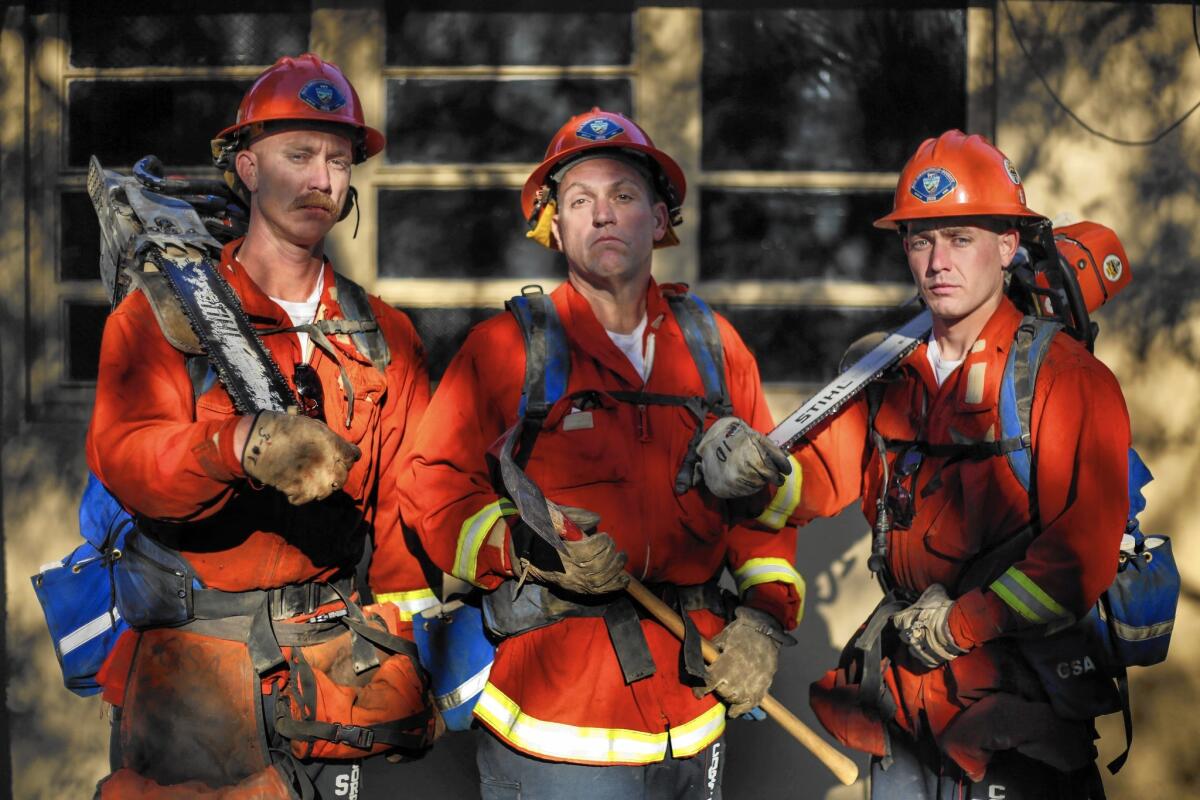Prop. 47 leaves future of California inmate fire crews uncertain

William Winegardner strode confidently near the head of the line of the Glen Helen 1 hand crew this summer as his team wrapped up a five-mile hike on a scorching day in San Bernardino. The sun beat on his back and sweat ran down his body like tiny rivers.
Standing 6 foot 4, with tattoos and a thick mustache, Winegardner led the crew of fellow jail inmates during a training session as they prepared for firefighting work and other emergency services.
But the future of his and other county jail fire crews across the state is now in doubt after the passage last week of Proposition 47.
The initiative reduces penalties for drug possession and other nonviolent crimes — something that could deplete the pool of jail inmates who qualify for fire duty.
San Bernardino County officials are now trying to sort out how the law will affect the inmate fire crews as well as other rehabilitation programs, said sheriff’s spokeswoman Jodi Miller.
“It could very well create an issue as far as having inmates eligible to be part of the inmate fire crew,” she said. “The inmates who could now be released from custody would be the ones that have the criminal history that allows them to be part of that program.”
Fire crews made up of nonviolent state prisoners have long been part of the bulwark that protects California during fire season. About 4,000 offenders participate in crews statewide, and officials estimate that they save California about $80 million in firefighting costs annually.
Winegardner’s crew was the first to be established out of the San Bernardino County jail system — an unanticipated byproduct of a sudden increase in prisoners to county jails that came with the state’s realignment policy. The rules brought nonviolent offenders who before had served their sentences in state prison to county jails instead as part of a bid to reduce prison overcrowding.
San Bernardino is one of several counties to use jail inmates on fire lines. Last year, the Los Angeles County Board of Supervisors agreed to send more than 500 low-risk inmates to various fire mountain camps in a bid to reduce jail overcrowding caused by realignment.
Fire officials had been counting on the county jail fire crews for help. The California Department of Forestry and Fire Protection had estimated that realignment would cut the number of fire crews from state prison by more than a third.
For Winegardner, his time on the fire crew provided a transition to what he hopes will be a new life.
Winegardner landed in jail twice for drug-related offenses. Last month, he finally got released and immediately applied for a job on the county fire crew. He’s waiting for an answer.
“For me to even be considered to get on with them shows that I’ve done good here,” Winegardner said. “Last time I didn’t have a job to go to, I didn’t have any of that. Now, I’m more confident. I know I’m going to do good this time.”
Two former crew members now have jobs with the U.S. Forest Service, and three current participants are being considered for jobs with the county Fire Department.
Since the program began last year with 15 inmates, it has grown to about 50 inmates. The goal is to grow to 96. Scores of inmates are on a waiting list to join the crew, officials say.
To be considered for the inmate crew, candidates must be low-level offenders serving a minimum of 15 to 18 months with no history of gang-related, sexual or violent crimes. For obvious reasons, they can’t have a disciplinary record or a history of trying to escape.
Once they’re accepted onto the crew, the inmates undergo five weeks of training that includes wildland fire suppression techniques.
The inmate crews go out into the community several days a week in their orange fire jackets. Regular fire crews wear yellow ones. They perform tasks that include clearing dry brush that could easily ignite and filling sandbags to protect buildings and streets from flooding during heavy rains.
For many, the community’s gratitude gave them a sense of pride.
“Instead of people saying, ‘Oh, here comes TJ that drug dealer,’ they’re like, ‘Hey, here’s TJ, the hard worker,’” said Tim Johnson, 49, of San Bernardino. “They respect me.”
For 10 years before he joined the program, Johnson had been in and out of jail on drug-related offenses. He counted the days to his release, thinking he would continue the same lifestyle that had landed him in jail. That changed after he joined the crew. Johnson was released from jail in September and, like Winegardner, he’s waiting to see if he gets hired.
“I’m at that age where it’s now or never,” Johnson said. “I gotta better myself, at least try to get some integrity back, some self-esteem. Do something productive in society again.”
Winegardner was on an inmate fire crew while at a state prison but still ended up in jail after his release. The difference now, he says, is the support he receives from the leaders of the San Bernardino County program, with whom he lives and has bonded.
San Bernardino County Sheriff’s Capt. Nina Jamson, the commander of the Glen Helen Rehabilitation Center, said the inmate fire crew members “learn to remove themselves from what they used to do. And they’re changing their attitude and looking at life differently.”
Recently, the program moved its participants into a fire camp about a mile up the road from the main jail. Instead of living crammed in tiny cells, the crews live in wide open spaces with beds lined up in rows to ease responses to emergency calls, day or night.
James Jones, 26, has used the free time to read volumes of magazines and self-help books on long-term goal planning and overcoming addiction.
Jones is serving time for selling drugs. But when he gets out Dec. 3 — a day after his grandmother’s birthday — he says he wants to use the skills he learned to become a “working family man.”
“I guess what we call it in here is a ‘normal person,’ ” the baby-faced Jones said with a laugh. “I know it sounds funny, but I definitely want to be a ‘normal.’ ”
After mudslides in Mt. Baldy in August, Glen Helen 1 was sent to assist homeowners in the cleanup.
One woman’s backyard took a particularly strong hit. She lived on the side of a mountain, and 10 feet of mud covered her backyard, completely engulfing a shed on the side of her house. The woman was distraught, Jones recalled.
His crew worked all day to clear the mud, eventually digging up what was left of the shed.
When they were done, the woman bought them a card to express her gratitude. Inside, she wrote: “Thank you to my angels in orange.”
Jones said being on the fire crew has taught him that though he has made mistakes in the past, there’s a second chance waiting to be seized.
“It’s the opportunity of a lifetime,” he said. “This whole program gave me a whole different motivation and reason to pursue a better future.”
More to Read
Sign up for Essential California
The most important California stories and recommendations in your inbox every morning.
You may occasionally receive promotional content from the Los Angeles Times.











